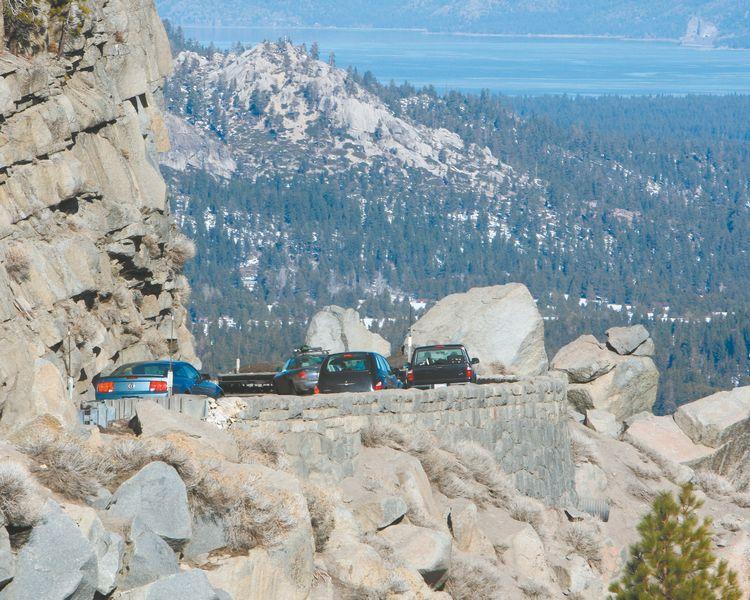SOUTH LAKE TAHOE, Calif. — Echo Summit has been in the news a lot lately due to a massive rockslide that forced the closure of U.S. Highway 50.
The highway has a long history of snow and rockslides since the highway was completed in 1939, but its history goes back even further.
“The history of Echo Summit is quite extensive dating back to the Gold Rush and wagon trails,” said Steve Nelson, public information officer for Caltrans District 3.
Families, like the Celio’s, used the route established through Echo Summit for cattle drives. Each summer they brought cattle into the basin from the California valley.
The U.S. Highway System was created in 1926 and construction on an established highway up and over Echo started shortly after.
“Johnson Pass was the original route over Echo Summit, but after the Echo Summit Sidehill Viaduct was completed between 1938 and 1939, Johnson Pass was bypassed and the route realigned into what is still used today,” Nelson said. “Obviously engineering and construction techniques have evolved a great deal since 1939, but for the original bridge to last more than 80 years is quite remarkable.”
The cost of building the bridge in 1939 was $25,000.
In the Caltrans Library, Nelson found this statement describing the viaduct after completion, “The property is an outstanding example of the U.S. Bureau of Public Roads’ careful design and engineering in an effort to meld a roadway into the natural beauty of the terrain. The effort resulted in the construction of numerous retaining walls, rock wall parapets, and a viaduct made of local granite, allowing full function of the facility while minimizing construction impacts to a recreational and scenic route. This was a challenging engineering feat with impressive results.”

Construction began in 2019 to replace the aging bridge. The project was completed ahead of schedule in 2020.
U.S. Highway 50 Echo Summit Sidehill Viaduct Replacement Project removed the existing bridge cost $14.1 million, $5.2 million of which came from Senate Bill 1, the Road Repair and Accountability Act of 2017.
The project required two weeks of complete closure of the highway and entailed “hauling and installing seven 96-foot precast girders from Utah to serve as the bridge deck and using ultra high-performance concrete for the first time in a high-elevation area to bind the bridge girders together with a faster curing time than traditional concrete,” the project description stated.
The American Association of State Highway and Transportation Officials recognized the project as a winner in their 2021 America’s Transportation Awards competition. The project was selected for best use of technology and innovation in the small project category (less than $25 million).
“AASHTO recognized Caltrans for our innovative approach on delivering this important project,” said Caltrans Director Toks Omishakin in a press release. “The end result is that we were able to significantly expedite construction while improving traveler safety along the Highway 50 corridor.”
The importance of Echo Summit has been proven in the last year. During the Caldor Fire, the highway acted as an evacuation route and allowed first responders to access the fire. In December 2021, a historic storm pummeled Lake Tahoe and every road in and out of the basin was closed — except for Echo Summit.
But last week’s rockslides were unsettling for frequent users of the pass. While rockslides aren’t unheard of on the road, the size of the boulders were alarming.
“There has always been a history of rockfalls onto the highway around Echo Summit due to the steep terrain, the mountain being right on top of the roadway and very little, if any, shoulder width in most locations,” Nelson said. “It’s similar to the snowslides and why Caltrans installed 13 canons over the highway for its avalanche control system to trigger a slide before Mother Nature does. However, the boulders that fell Thursday (March 3) were much larger than usual.”
The boulder that fell last Thursday was estimated at 458 tons, 23 feet long and 14 feet tall.
Despite the rockslides, US 50 remains a fairly safe road.
According to a California Highway Patrol spokesperson, there have been no deaths related to rockslides and very few injuries, just some damage to passing vehicles.
Crews have spent all week rock scaling, which is the act of removing unstable or potentially unstable rock by using hand tools.
“It’s very difficult to predict a rockslide in advance, but our South Lake Tahoe maintenance staff does monitor the cliffs daily and is trained in rock-scaling and explosives for boulder blasting,” Nelson said. “Rockslides are often triggered when snow melts into water during daytime warmer temperatures and then freezes overnight. The ice inside cracks in the boulders can expand the rock and cause it to shift. Our geologists believe that was the case with Thursday’s slide.”
The Caldor Fire is also responsible for last week’s rockslides.
“Hundreds of hazardous trees throughout the corridor have to be removed either because they were destroyed by the fire or the terrain can no longer support them due to damage from the fire,” Nelson said, adding that it caused instability to the slope and burn scars impacted erosion.
Two emergency director’s orders were put in place following the fire.
“It was critical to get two emergency contracts into place so soon after the fire was contained to address 29 miles of highway. One is from Sierra-at-Tahoe to Meyers with Granite Construction the primary contractor. The other is from Pollock Pines to Sierra with Doug Veerkamp General Engineering,” Nelson said.
The Granite Construction contract was $16.5 million and multiple elements to it in order to improve safety, drainage, erosion control and rock slope stabilization.
Nelson said, “Work on the highway will continue into July and will include repaving Highway 50 from Echo Summit to Meyers.”
